Conversation
Toph Tucker and Jasmine Lee on Why Restaurant Websites Are Good and We’re All Going to Miss Them
1/10/2019
Meg Miller and Laurel Schwulst
Laurel Schwulst:
Late last summer you tweeted:
What made you start thinking about restaurant websites then?
Toph Tucker:
At the time, I was about to meet with my friend at the Astro Restaurant, a diner in midtown Manhattan. I wanted to check the menu before I arrived.So I looked at the website. It was a particularly incredible one, with a very distinct aesthetic. It had so much personality with many little personal notes from whomever was making it. It gave me a good sense of what the restaurant would be like before I arrived. And surprisingly, it didn’t need photographs of the restaurant to do that.
Meg Miller:
What was Astro Diner actually like?Toph:
Even though it had allusions to events in its past and had built up a sort of history—like it was clearly a Midtown staple—the restaurant was totally unpretentious. That’s the most important part. It had a pretty extensive classic diner menu, which was not concerned with typos or consistent fonts or really any kind of consistency at all.I just looked back at its website today. I noticed they had special Thanksgiving hours and schedule. So they also keep the website quite updated.
Laurel:
Literally speaking, what makes up the website? Text? Images?Toph:
The website itself is a lot of text. The menu is not an uploaded PDF or a photo of the menu. It’s a text menu, which is helpful because it’s searchable. But there are also images. There’s an animated Flash-style slideshow with windowshade-like transitions where the new image slides over the old one from several points at once.I’d imagine someone is probably editing .html files over FTP. It doesn’t look like there's any kind of CMS layer like Squarespace because there’s inconsistency within navigational elements, and different pages have sufficiently different layouts. The site doesn’t appear to be on any kind of template or grid.
Jasmine Lee:
It’s like a generational website. That is, a website of a specific time. Those often have a certain personality and maybe aren’t as pretentious.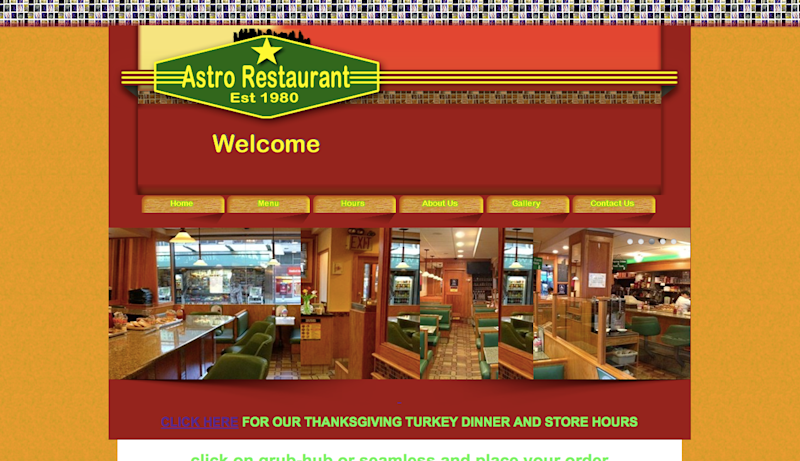
Laurel:
That other part of your tweet was kind of ominous. I believe you said “we’re all going to miss” restaurant websites. So where are they going?Toph:
Into the stacks [laughs]. Between templated website builders and Facebook and also these centralized menu platforms…Probably at the time a lot of these websites were made, FTP was the easiest option available. There wasn’t an ecosystem of toolkits at the time. The only option that was available happened to be very expressive and freeform. The frameworks that exist now are much more confined and templated by default.
Meg:
You don’t even have to go to a restaurant’s website anymore. You can get the menu on Yelp and opening hours on Google Maps.Toph:
I’ve been asking people, “What are your favorite restaurant websites?” And sometimes people have responses, but most people have just been saying, “What are you talking about? I never look at restaurant websites. Why would I?” So I think we’re already at a point now where most restaurants that still have websites are dated from an era.Jasmine:
That may be true in the U.S. But my favorite restaurant websites, which will maybe speak to that spirit you are referring to, are restaurant websites in Japan where there’s this kind of rounded quality to them. Maybe I'm thinking of the font choice.These websites are very generous, too—in terms of giving the history and the mission, and the ingredients that the restaurant chooses to use—in a way that you don’t really see in the U.S. In the U.S., they’re usually just parked to say, “we exist in the world.”
Laurel:
What makes restaurant websites, the good ones anyway, so good?Toph:
They’re so good when the atmosphere of the place comes across. It seems that the restaurant space remains much more dominated by a specific personality, in comparison to other establishments that sell music, movies, books, or almost anything else. I guess because it’s hard to download food.Jasmine:
Was the website experience for the Astro Restaurant comparable to your real life experience?Toph:
Yeah, it was exactly what I expected, in a good way. It was a classic midtown diner that felt unpretentious. It had an expansive, good menu. I got a cheeseburger after all that. I didn’t even need a menu at all. I think that the interior decor and its palette matched the website pretty well.Jasmine:
What were the colors they were working with?Toph:
It was sort of earthy.Laurel:
And geometric shapes, right?Toph:
You know it.Jasmine:
I was thinking like a turquoise.Toph:
It was actually not at all celestial. The name alone is not enough. That’s why you need the website.Jasmine:
We also don’t expect restaurant websites to be very “good.” It’s one type of professional website that can get away with that. Most professionalized businesses can’t get by with a “bad” website.Meg:
I was trying to think of a point of comparison. I used to work in book publishing, and writers often have terrible websites. This was because at some point, the marketing department told writers that if they’re going to have a book, they also have to have a website. But these writers’ websites usually aren’t as interesting as the restaurant websites. I wonder if it’s because restaurants are physical places where you can have an experience.Toph:
Strangely enough, hedge fund websites have the same dynamic going on as writer websites and restaurant websites. There are some structural similarities in that many of them employ relatively few people, so they can be fairly individualized. And the website is really not the point of hedge funds, so their website doesn’t matter enough to be homogenized. But also until very recently, there were SEC regulations that a hedge fund was not allowed to produce anything that resembled marketing. They already had the domain for their email addresses, so they just threw something up on the domain as parking, like you were saying before, Jasmine. It basically resembles a calling card, like a single bitmap image centered on the page.Laurel:
Speaking of things you can’t download, like experiences and foods and smells, perfume websites are also often crazy. They’re all about marketing and the story so you’ll actually try them.Jasmine:
They often have a sound component.Meg:
It’s fascinating we’re talking about sounds of a perfume website. That sounds immediately come to mind for you when you think of perfume online.Jasmine:
Yeah, how else would you convey the senses? Also perfumes rely so heavily on the bottle and the packaging to give it dimension. So the website should have dimension.Meg:
Or maybe it just reminds you that there are senses, because a website can't give you smell.Toph:
Yeah it’s like “I’m a body! I’m not just a brain in a vat.” That’s what restaurant websites remind you—that you have a gut; you have a whole digestive tract.
Meg:
The Dimes website seems very unique and handmade. However, it’s also very branded, and as we’ve researched, it’s actually running on Squarespace.Toph:
This website changed my mind. A while ago, I had prejudices against modern CMSes like Squarespace. I even tweeted about Squarespace threatening this genre of restaurant websites. And then I looked at the Dimes website, and decided I shouldn’t fetishize or villainize the tool alone.Laurel:
Clearly the Dimes people wanted this feeling of slightly old web. They even have a sort of links to friends page, which is an optimistic nod to the past. But I’m still kind of surprised it's a Squarespace.Jasmine:
We were talking earlier about how older websites have no CMS. But all it really takes is someone who knows how to work a little bit of front-end programming magic, and then you have an existing CMS for your client to plug everything in. That’s a nice thing.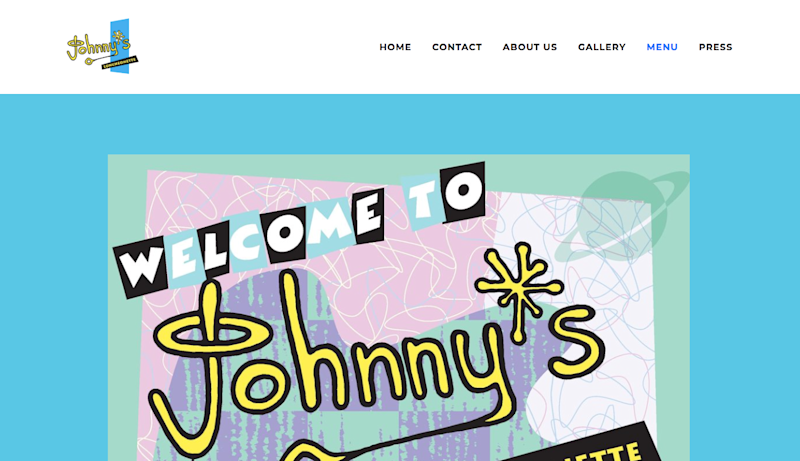
Toph:
One of my favorite sites is for another diner, Johnny's Luncheonette in my hometown of Newton, Massachusetts. The website is giant images of their paper menu, and their paper menu has remained essentially unchanged as long as I can remember. I have fond early memories of it going back to middle school.
Jasmine:
Speaking of giant menu websites, I was remembering Congee Village’s website. Chinese menus are huge, and Congee Village has the whole printed file that you have to traverse online. I really enjoy it, maybe because I’m already so familiar with the menu. It was just funny translating that experience into a very flat web space. The menu is unfolded online!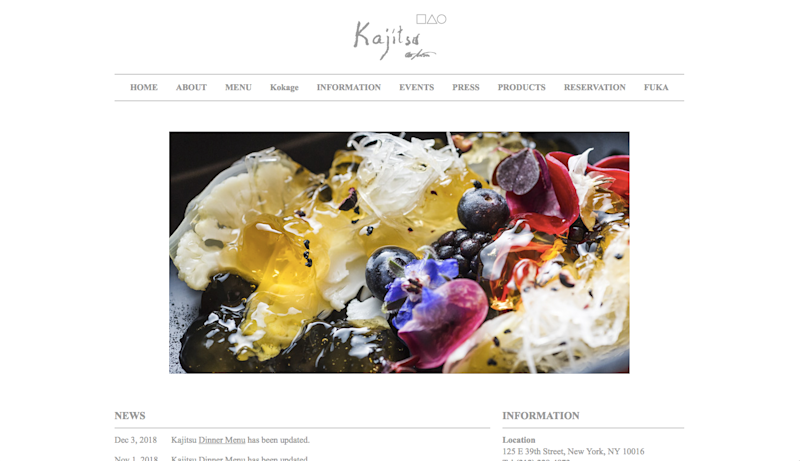
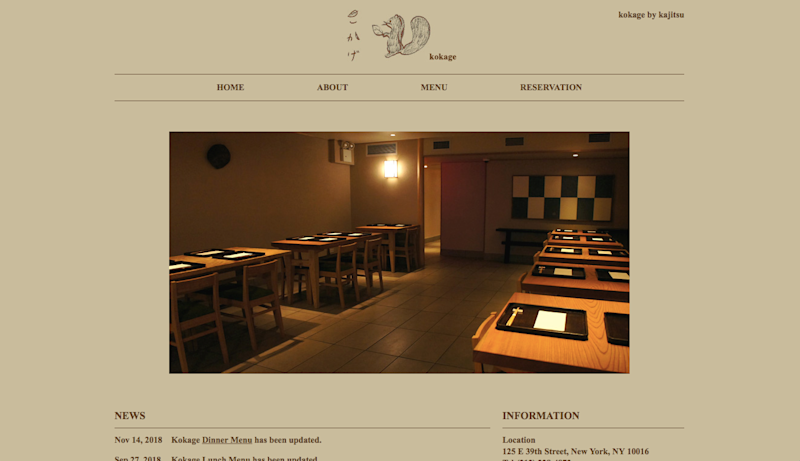
Jasmine:
Another website I really like is Kajitsu’s and its sister restaurant Kokage’s.Kajitsu’s website conveys seasonality, which is a huge aspect of their menu. They change their menu with the seasons. Online, there’s an archive of their menu per season, per year. Which is another thing that I’ve never seen before—a menu archive. This is very useful in thinking about restaurants as publishers.
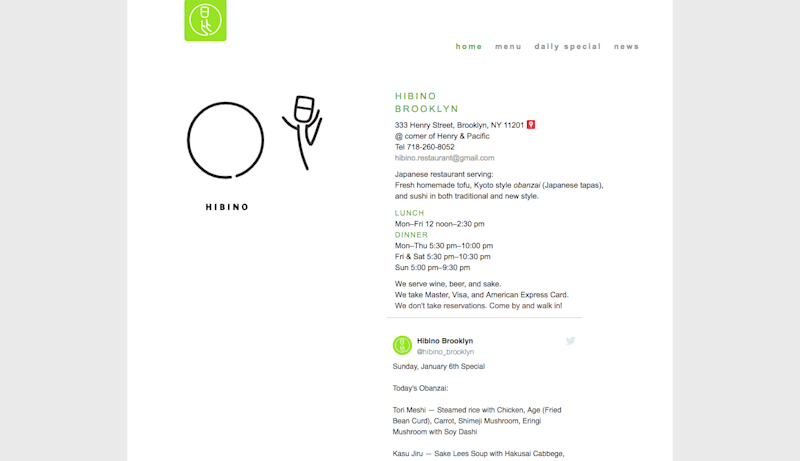
Laurel:
Hibino’s website has an animation, which you can’t see anywhere else. Their symbol becomes a chef who jumps out of a bowl and dances. Jasmine:
Hibino updates their website daily for their lunch special, which is a huge thing. It’s a lot of work.Becca Abbe:
I follow them on Twitter. Every day they tweet the specials. I get a little jealous.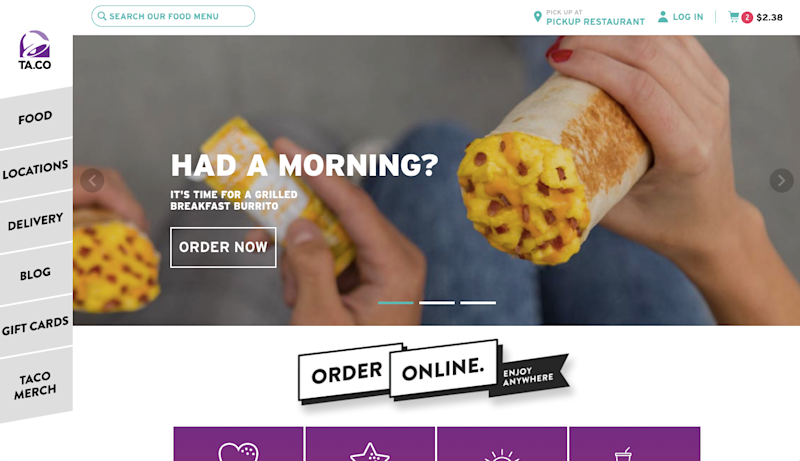
Toph:
I also posted the prompt on Linkedin, “What are your favorite restaurant websites?” Someone said Taco Bell, which feels like an appropriate Linkedin response. They said Taco Bell has a carousel of ideas for customizing your order. And then someone else came along on the Linkedin comment thread and said, “You beat me to it!”
Jasmine:
Did anyone say Dominos?Becca:
They made waiting for pizza fun.Jasmine:
Yeah, with their pizza tracker. They were really on the bleeding edge.Becca:
They even tell you the name of the person working on your order…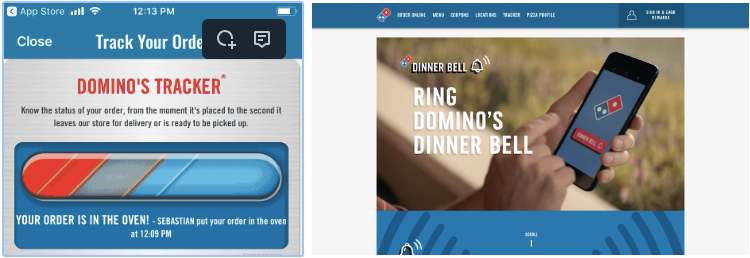
Meg:
So Toph, your tweet that sparked this further investigation into websites got some responses. There was one that said their favorite restaurant website was a Facebook page, but I always hate it when restaurants only have Facebook pages…Toph:
In the small town where I went to college, my favorite diner only has a Facebook page. I follow it, and they don't really have much to say besides, “We're still here.” But I love that.In platforms that separate the content from the code, I’m lamenting the loss of expressive control for the typical person who makes a restaurant website today.
If there’s a story you want to tell or a vibe you want to convey, or an aesthetic, or some news, or a new development, or a new menu or something—any of that can be conveyed within a content container on Facebook, Instagram, Wordpress, Squarespace or another modern tool.
But when you do that, you forfeit a whole layer of choice in terms of how things relate to each other. Everything doesn’t just have to be a bunch of pages that have some number of tags. Maybe the menu items could be something other than just elements in a list. Like maybe they have relationships to each other, or maybe they’re changing over time, and you want to capture that change. Or maybe they have people attached them, or there is someone special who prepared the dish, or there’s a process by which it’s prepared, or maybe there’s a seasonality or periodicity to it. Or there’s some special scarcity or ability to “build your own,” or there are modifications allowed. Or maybe special music plays in the restaurant or different music plays at different times. Or people have control over elements of the atmosphere, or the atmosphere changes depending on who’s there, or depending on if there’s a party or if you rent the room or something. Anyway, there’s a lot to the experience that’s very meaningful that doesn’t fit into a pages, tags, posts, and feeds model.
Jasmine:
That makes me wonder about the actual person creating and updating the website. So far we haven’t discussed the “who.” We’re talking about these websites, but not the labor behind them. Who do you think is updating a restaurant website?Like we’ve been saying, most restaurant websites are just parked, like territory. Which is why I’m very into the idea of restaurant people using CMSes. I don’t think there’s anything bad about them. Before, you weren’t in favor of restaurant websites running on CMSes because they didn’t have that flexibility or spontaneity that you’re referring to. But they make updating a website easier. I think most restaurants don’t update their websites because it’s a lot of labor on top of all the existing demands of running a business.
The incredible thing about Astro Restaurant is that someone is still updating it. One of the first things you mentioned was that you could see there was a “hand,” that someone was updating it, and that the clunkiness made it special. Who is this person? And why aren’t people doing that today?
Often today the person updating the restaurant website is just the restaurant manager. Even the newer sites. Since the margins are so slim for most in the industry, your average restaurant doesn’t have the capacity to hire a web or content manager.
Toph:
That's an incredibly important point. There's really nothing I can say having never been in that position myself.I think it’s fine if nobody updates the site manually. What I care about most is what the tools of the day make easy and what they make hard. I don’t want everyone in the world to have to learn how to code, but I think there are things that coding makes possible that the current tools have made very hard. Ideally digital environments wouldn’t make such a strong distinction between coders and non-coders. I like to think that that's possible.
I want the burden to fall more on better tools for expressive design and less on asking more from people who are already running the restaurant, which is the part that really matters.
Now I just have to ask. Do people who run restaurants have any of these sort of nostalgic laments? Or are they just happy because the new stuff reaches so many more people in the industry?
Jasmine:
No, there’s absolutely no nostalgia for the web from the position of restaurant workers. I think nostalgia in this context is a privilege. For restaurants, social media is a blessing and a curse. While it reaches a much larger audience, restaurants also become dependent on it to convey their mood or spirit.Sometimes social media even determines exactly what I want to eat at a restaurant. I’ve seen an alluring image of a specific dish on Instagram, for instance. Sometimes this feels really evil. There’s no pleasure in discovery. If I were to be nostalgic, that’s what I would miss.
Meg:
In lamenting restaurant websites’ disappearing, what might their ideal future be?Jasmine:
I would like to see restaurant websites operating more as publishers. Similar to how Kajitsu does with their archive of seasonal menus. Maybe it means that restaurant websites simply start blogging instead of having parked websites.Becca:
Maybe a restaurant is really just a physical blog.
Toph Tucker is a programmer in New York.
Jasmine Lee is a writer, researcher, and cook who lives in Queens.
Becca Abbe is a designer and programmer thinking in New York. She works on commercial, collaborative, and personal projects under the name Cdxs.
Laurel Schwulst is a webmaster and writer breathing in New York.
Meg Miller edits the Are.na blog.
Are.na Blog
Learn about how people use Are.na to do work and pursue personal projects through case studies, interviews, and highlights.
See MoreYou can also get our blog posts via email